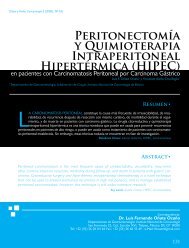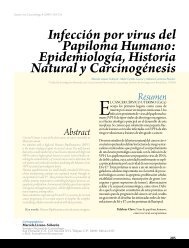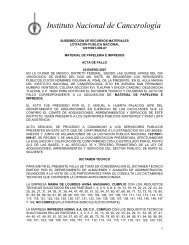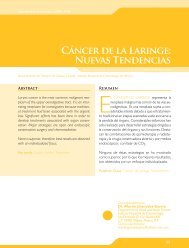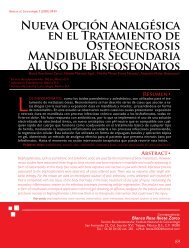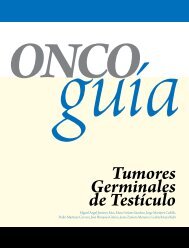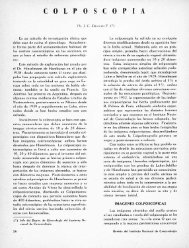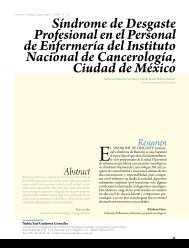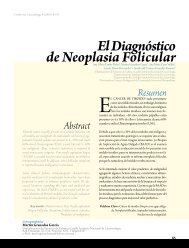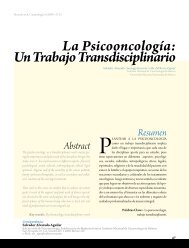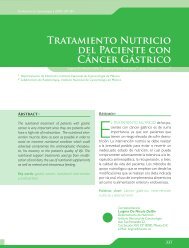VPH y los Carcinomas de Cavidad Bucal y Bucofaringe - Instituto ...
VPH y los Carcinomas de Cavidad Bucal y Bucofaringe - Instituto ...
VPH y los Carcinomas de Cavidad Bucal y Bucofaringe - Instituto ...
Create successful ePaper yourself
Turn your PDF publications into a flip-book with our unique Google optimized e-Paper software.
García et al, Cancerología 4 (2009): 181-191<br />
<strong>VPH</strong> y <strong>los</strong> <strong>Carcinomas</strong> <strong>de</strong><br />
<strong>Cavidad</strong> <strong>Bucal</strong> y <strong>Bucofaringe</strong><br />
Abstract<br />
Upper aero-digestive tract cancer (UADTC) is the sixth most common<br />
cancer with an annual inci<strong>de</strong>nce of approximately 400,000 worldwi<strong>de</strong>.<br />
Although the principal risk factors for UADTC remain tobacco and<br />
alcohol use, human papillomavirus (HPV) has recently been found to<br />
be etiologically associated with 20 to 25% of UADTC, mostly in the<br />
oropharynx. HPV causes human cancers by expressing two viral oncoproteins,<br />
E6 and E7. Studies have shown that E6 and E7 can directly<br />
bind to multiple host proteins as p53 and pRb, further contributing to<br />
genetic instability. The most common high risk-HPV associated with<br />
upper aero-digestive tract cancer is HPV-16. High risk-HPV positivity<br />
is associated with <strong>de</strong>creased expression of the p53 and Rb genes,<br />
overexpression of p16, <strong>de</strong>creased expression of EGFR , and a different<br />
genetic expression pattern compared with patients with high risk-HPVnegative<br />
UADTC, leading to the conclusion that this is a distinct clinical<br />
entity. In addition to the etiological differences, HPV-positive cancers<br />
are clinically distinct when compared with HPV-negative cancers with<br />
regard to treatment response and survival outcome, with tumor HPVpositivity<br />
being a favorable prognostic biomarker.<br />
Key words: Upper aero-digestive tract cancer,<br />
human papillomavirus, treatment, prognosis, etiology.<br />
Claudia M. García-Cuellar1 , Imelda <strong>de</strong>l Carmen González Ramírez2 y Martín Granados García3 1 Subdirección <strong>de</strong> Investigación Básica. <strong>Instituto</strong> Nacional <strong>de</strong> Cancerología<br />
2 Doctorado en Ciencias Biológicas <strong>de</strong> la Universidad Autónoma Metropolitana<br />
3 Departamento <strong>de</strong> Tumores <strong>de</strong> Cabeza y Cuello. <strong>Instituto</strong> Nacional <strong>de</strong> Cancerología<br />
Resumen<br />
EL CÁNCER DE LA VÍAS AERODIGESTIVAS<br />
superiores (CVADS) representa la sexta malignidad<br />
más común, con una inci<strong>de</strong>ncia anual<br />
aproximada <strong>de</strong> 400.000 personas en el mundo.<br />
Aunque <strong>los</strong> principales factores <strong>de</strong> riesgo para el CVADS<br />
siguen siendo la exposición al tabaco y alcohol, el virus <strong>de</strong>l<br />
papiloma humano (<strong>VPH</strong>) recientemente se ha encontrado<br />
asociado en la etiología <strong>de</strong>l 20 al 25 % <strong>de</strong> <strong>los</strong> CVADS,<br />
principalmente <strong>los</strong> ubicados en la bucofaringe. En humanos<br />
el <strong>VPH</strong> es causa <strong>de</strong> cáncer por expresar dos oncoproteínas<br />
virales: E6 y E7. Los estudios han <strong>de</strong>mostrado que<br />
E6 y E7 se unen directamente a varias proteínas <strong>de</strong>l hospe<strong>de</strong>ro,<br />
como p53 y pRb, para contribuir a la inestabilidad<br />
genética. El tipo <strong>de</strong> <strong>VPH</strong> <strong>de</strong> alto riesgo más asociado con<br />
cáncer <strong>de</strong> las vías aerodigestivas superiores es <strong>VPH</strong>-16. La<br />
positividad a <strong>VPH</strong> <strong>de</strong> alto riesgo se asocia a una expresión<br />
disminuida <strong>de</strong> <strong>los</strong> genes p53 y pRb, la sobreexpresión <strong>de</strong><br />
p16 y la disminución <strong>de</strong> la expresión <strong>de</strong> EGFR, y un patrón<br />
<strong>de</strong> expresión genética diferente respecto a <strong>los</strong> pacientes<br />
con CVADS negativo a <strong>VPH</strong> <strong>de</strong> alto riesgo, esto conduce a<br />
la conclusión <strong>de</strong> que se trata <strong>de</strong> una entidad clínica distinta.<br />
A<strong>de</strong>más <strong>de</strong> las diferencias etiológicos, <strong>los</strong> cánceres <strong>VPH</strong>positivos<br />
son clínicamente diferentes en comparación con<br />
<strong>los</strong> cánceres <strong>de</strong> <strong>VPH</strong> negativos en relación con la respuesta<br />
al tratamiento y la supervivencia, siendo la positividad a<br />
<strong>VPH</strong> un biomarcador pronóstico favorable..<br />
Palabras Clave: cáncer <strong>de</strong> vías aerodigestivas superiores,<br />
Virus <strong>de</strong>l papiloma humano, tratamiento, pronóstico, etiología.<br />
Correspon<strong>de</strong>ncia:<br />
Dra. Claudia M. García-Cuellar<br />
Subdirección <strong>de</strong> Investigación Básica, <strong>Instituto</strong> Nacional <strong>de</strong> Cancerología.<br />
San Fernando No. 22, Tlalpan, 14080 México DF, México. Tel. (+52-55) 5628-0462; Fax: (+52-55) 5628-0432<br />
e-Mail: claudia.garciac@salud.gob.mx<br />
181
182<br />
Introducción<br />
El cáncer escamoso <strong>de</strong> las vías aerodigestivas superiores<br />
(CE-VADS) (con frecuencia <strong>de</strong>nominado en<br />
forma imprecisa, cáncer <strong>de</strong> cabeza y cuello), representa<br />
2 a 3% <strong>de</strong> las malignida<strong>de</strong>s diagnosticadas en<br />
nuestro país (1). Aunque es relativamente raro, se<br />
trata <strong>de</strong> una entidad importante, ya que su pronóstico<br />
es malo y las secuelas <strong>de</strong>l tratamiento suelen ser<br />
<strong>de</strong>vastadoras. Hasta 60% <strong>de</strong> lo casos son diagnosticados<br />
en etapas avanzadas (ECIII y IV) y el pronóstico<br />
<strong>de</strong> supervivencia oscila entre 10 y 40% a 5 años,<br />
<strong>de</strong>pendiendo el sitio especifico y su resecabilidad<br />
(2). En tanto que el tratamiento en etapas avanzadas<br />
esta compuesto <strong>de</strong> combinaciones <strong>de</strong> cirugía,<br />
radioterapia y quimioterapia, esta combinación <strong>de</strong><br />
tratamientos con frecuencia produce pérdidas funcionales<br />
severas y significativo <strong>de</strong>terioro estético.<br />
Dentro <strong>de</strong>l CE-VADS, el cáncer bucal y bucofaríngeo<br />
(CByBF) representan un grupo importante, ya que<br />
dan cuenta <strong>de</strong>l 50% <strong>de</strong> las malignida<strong>de</strong>s <strong>de</strong> esta región<br />
(que también incluye a la laringe, hipofaringe, fosas<br />
nasales, senos paranasales y el esófago cervical). Con<br />
frecuencia, estas neoplasias son estudiadas en conjunto,<br />
ya que existe la noción <strong>de</strong> que comparten aspectos<br />
etiológicos, fisiopatológicos, abordajes diagnósticos y<br />
principios <strong>de</strong> tratamiento, aunque evi<strong>de</strong>ncia reciente<br />
sugiere que esto podría no ser <strong>de</strong>l todo cierto.<br />
Específicamente, la mayoría <strong>de</strong> <strong>los</strong> cánceres bucales<br />
se <strong>de</strong>sarrollan en la lengua móvil (dos tercios anteriores<br />
<strong>de</strong> la lengua) y el piso <strong>de</strong> la boca, mientras que en<br />
la bucofarínge son más comunes en la base <strong>de</strong> lengua<br />
(el tercio posterior <strong>de</strong> la lengua) y la fosa amigdalina.<br />
Aunque en la fosa amigdalina aumenta la proporción<br />
<strong>de</strong> linfomas, en conjunto, un 90% <strong>de</strong> <strong>los</strong> tumores son<br />
carcinomas <strong>de</strong> células escamosas.<br />
Como ya mencionamos, <strong>los</strong> cánceres <strong>de</strong> la cavidad<br />
bucal y la bucofaringe han sido asociados a <strong>los</strong> mismos<br />
factores <strong>de</strong> riesgo y etiológicos, principalmente<br />
<strong>los</strong> <strong>de</strong>rivados <strong>de</strong> la exposición al tabaco y el alcohol,<br />
sin embargo, existe evi<strong>de</strong>ncia que sugiere que el virus<br />
<strong>VPH</strong> y <strong>los</strong> <strong>Carcinomas</strong> <strong>de</strong> <strong>Cavidad</strong> <strong>Bucal</strong> y <strong>Bucofaringe</strong><br />
<strong>de</strong>l papiloma humano (<strong>VPH</strong>) juega un importante<br />
papel en la patogénesis <strong>de</strong>l carcinoma escamoso <strong>de</strong><br />
la cavidad bucal, y en especial <strong>de</strong> la bucofaringe, con<br />
in<strong>de</strong>pen<strong>de</strong>ncia <strong>de</strong> la participación <strong>de</strong>l tabaco, el alcohol<br />
o ambos (3, 4). Aún más, podrían existir dos<br />
perfiles <strong>de</strong> pacientes con sus respectivas enfermeda<strong>de</strong>s,<br />
aquel<strong>los</strong> asociados a la infección <strong>de</strong>l <strong>VPH</strong> y <strong>los</strong><br />
relacionados a la exposición al tabaco y alcohol. Los<br />
primeros tendrían una mejor respuesta al tratamiento<br />
y mejor pronóstico. Si esto se corrobora, tendría<br />
profundas implicaciones en la forma que se evalúa a<br />
<strong>los</strong> pacientes, se analizan <strong>los</strong> riesgos y beneficios para<br />
tomar <strong>de</strong>cisiones terapéuticas, y en la interpretación<br />
<strong>de</strong> <strong>los</strong> resultados <strong>de</strong> <strong>los</strong> ensayos clínicos.<br />
El objetivo <strong>de</strong> esta revisión es presentar la información<br />
disponible en relación a la participación <strong>de</strong>l<br />
<strong>VPH</strong> en la génesis <strong>de</strong>l CByBF y presentar un panorama<br />
<strong>de</strong> las líneas <strong>de</strong> investigación relacionadas a<br />
las implicaciones terapéuticas.<br />
Biología <strong>de</strong> Virus <strong>de</strong>l Papiloma<br />
Humano (<strong>VPH</strong>)<br />
El virus <strong>de</strong>l papiloma humano (<strong>VPH</strong>) forma parte <strong>de</strong><br />
la familia <strong>de</strong> <strong>los</strong> Papillomaviridae. Es un virus epiteliotrópico<br />
que pue<strong>de</strong> inducir lesiones hiperplásicas,<br />
papilomatosas y verrucosas en el epitelio escamoso<br />
estratificado <strong>de</strong> la piel y las mucosas (5, 6).<br />
Los <strong>VPH</strong> poseen una sola molécula <strong>de</strong> DNA <strong>de</strong> doble<br />
ca<strong>de</strong>na, formada por 8,000 pares <strong>de</strong> bases aproximadamente<br />
(7), que mi<strong>de</strong> unos 50 nm <strong>de</strong> diámetro.<br />
Se ha reportado la existencia <strong>de</strong> más <strong>de</strong> 120 tipos<br />
diferentes <strong>de</strong> <strong>VPH</strong>, sin embargo, solo se ha secuenciado<br />
el genoma completo <strong>de</strong> unos 100 tipos (8, 9).<br />
La organización genética <strong>de</strong> todos <strong>los</strong> <strong>VPH</strong> es similar,<br />
formada por tres gran<strong>de</strong>s regiones, una región<br />
temprana en la que se encuentran <strong>los</strong> genes responsables<br />
<strong>de</strong> la transcripción, replicación y transformación,<br />
conocidos como genes E (E1, E2, E4, E5, E6,<br />
E7 y E8), una región tardía, que codifica dos proteínas<br />
<strong>de</strong> la cápsi<strong>de</strong>, L1 mayor y L2 menor, y finalmente
García et al, Cancerología 4 (2009): 181-191<br />
una región larga <strong>de</strong> control, que contiene elementos<br />
<strong>de</strong> regulación para la transcripción y replicación<br />
viral (8). Es importante señalar que la información<br />
genética se encuentra codificada en una sola <strong>de</strong> las<br />
ca<strong>de</strong>nas <strong>de</strong> DNA, <strong>de</strong>bido a que <strong>los</strong> genes tienen una<br />
sola orientación transcripcional (7) (Figura 1).<br />
E6<br />
E5<br />
E7<br />
E2<br />
E1 E4 E1 E4<br />
RLC Genes Tempranos Genes Tardíos<br />
E1<br />
E2<br />
E4<br />
Inicio <strong>de</strong> replicación viral<br />
= ~ 8000 pb<br />
Regulación<br />
<strong>de</strong> la transcripción<br />
Ruptura <strong>de</strong> citoqueratinas<br />
Transformadora<br />
<strong>de</strong> membranas<br />
Degrada p53<br />
y activa telomerasa<br />
Se une a pRb<br />
Figura 1 ■<br />
Genoma <strong>de</strong>l <strong>VPH</strong>.<br />
Infección <strong>de</strong>l <strong>VPH</strong><br />
y Transformación Maligna<br />
La transmisión <strong>de</strong> <strong>los</strong> <strong>VPH</strong> es diversa: pue<strong>de</strong> ocurrir<br />
en el periodo perinatal (10), y más a<strong>de</strong>lante en la vida,<br />
por contacto sexual (11) y auto inoculación, (12)<br />
aunque algunos autores sugieren a<strong>de</strong>más, una posible<br />
transmisión por saliva (13). La infección pue<strong>de</strong> adquirirse<br />
en diferentes etapas tempranas <strong>de</strong> la vida, ya<br />
que se ha <strong>de</strong>mostrado la presencia <strong>de</strong> este virus en 6%<br />
<strong>de</strong> la población infantil, 13% <strong>de</strong> <strong>los</strong> adolescentes y en<br />
el 23% <strong>de</strong> la población adulta (12).<br />
E5<br />
E6<br />
E7<br />
Cada tipo <strong>de</strong> <strong>VPH</strong> se encuentra asociado con el <strong>de</strong>sarrollo<br />
<strong>de</strong> lesiones específicas que se localizan en sitios<br />
anatómicos <strong>de</strong>finidos <strong>de</strong>l epitelio escamoso cutáneo y<br />
mucoso (14). Los <strong>VPH</strong> se han clasificado en dos gran<strong>de</strong>s<br />
grupos, basados en el tipo y pronóstico <strong>de</strong> la lesión<br />
que son capaces <strong>de</strong> inducir <strong>de</strong>spués <strong>de</strong> la infección, en<br />
virus <strong>de</strong> alto y bajo riesgo (15).<br />
El cáncer <strong>de</strong> cérvix se ha utilizado como mo<strong>de</strong>lo en<br />
la patogénesis <strong>de</strong> las neoplasias malignas mediadas<br />
por la infección <strong>de</strong>l <strong>VPH</strong>. En el cáncer cervical el ge-<br />
noma <strong>de</strong>l <strong>VPH</strong> con frecuencia se encuentra, aunque<br />
no exclusivamente, integrado en el genoma <strong>de</strong> la célula<br />
huésped (16). La integración <strong>de</strong>l genoma viral<br />
al DNA celular, provoca el rompimiento <strong>de</strong>l gen E2,<br />
dando como resultado la perdida <strong>de</strong> control transcripcional<br />
mediado por E2, llevando a una <strong>de</strong>sregulación<br />
<strong>de</strong> la expresión <strong>de</strong> las oncoproteinas E6 y E7. Es<br />
<strong>de</strong>cir, la transcripción <strong>de</strong> <strong>los</strong> oncogenes E6 y E7 inicialmente<br />
es reprimida por la proteína E2 (17, 18).<br />
Las infecciones por <strong>VPH</strong> con alta carga viral son<br />
capaces <strong>de</strong> producir gran<strong>de</strong>s cantida<strong>de</strong>s <strong>de</strong> unida<strong>de</strong>s<br />
<strong>de</strong> proteína E6 y E7, cuya acumulación en pacientes<br />
con sistemas inmunológicos incompetentes<br />
al bloquear la acción <strong>de</strong> p53 y RB incrementa el<br />
riesgo <strong>de</strong> transformación maligna (19).<br />
La forma <strong>de</strong> replicación <strong>de</strong>l <strong>VPH</strong> es diferente <strong>de</strong>pendiendo<br />
<strong>de</strong>l tipo <strong>de</strong> lesiones; en las lesiones benignas<br />
el genoma <strong>de</strong>l <strong>VPH</strong> se integra <strong>de</strong> forma episomal extracromosómico<br />
(plásmido) mientras que en las lesiones<br />
malignas, como las <strong>de</strong>l cérvix, el DNA viral se<br />
integra en el cromosoma <strong>de</strong>l hospe<strong>de</strong>ro (7). Como<br />
en el cáncer cervical, en el CByBF el genoma <strong>de</strong>l <strong>VPH</strong><br />
pue<strong>de</strong> encontrarse <strong>de</strong> forma episomal, integrado o <strong>de</strong><br />
ambas formas (17, 18). Si bien, en algunos carcinomas<br />
<strong>de</strong> las VADS, principalmente <strong>los</strong> <strong>de</strong> amígdala,<br />
no se aprecia integración <strong>de</strong>l DNA-<strong>VPH</strong>, pero pue<strong>de</strong><br />
<strong>de</strong>tectarse la expresión <strong>de</strong> <strong>los</strong> oncogenes virales, lo<br />
cual indica que la integración <strong>de</strong>l DNA-<strong>VPH</strong> no es<br />
un evento necesario para la carcinogénesis (17).<br />
Con base en evi<strong>de</strong>ncia molecular y epi<strong>de</strong>miológica,<br />
en 1995 la Agencia Internacional <strong>de</strong> Investigación<br />
en Cáncer (IARC) reportó el efecto carcinogénico<br />
<strong>de</strong> <strong>los</strong> <strong>VPH</strong> tipo 16 y 18 en humanos (20). Por otro<br />
lado, <strong>de</strong>s<strong>de</strong> 1983, Syrjanen y cols (21), observaron<br />
algunas características morfológicas e inmuno histoquímicas<br />
indicativas <strong>de</strong> infección por <strong>VPH</strong> en<br />
<strong>los</strong> carcinomas bucales <strong>de</strong> células escamosas. Con<br />
el primer reporte <strong>de</strong> <strong>de</strong>tección <strong>de</strong> <strong>VPH</strong> <strong>de</strong> alto riesgo,<br />
en especial <strong>los</strong> tipos 16,31 y 33 en <strong>los</strong> CE-VADS<br />
(22), se inicio la búsqueda <strong>de</strong> la asociación <strong>de</strong> este<br />
biomarcador con la presencia <strong>de</strong> CE-VADS.<br />
183
184<br />
Cáncer <strong>Bucal</strong> y Bucofaríngeo<br />
En México, la información epi<strong>de</strong>miológica con relación<br />
al CByBF es escasa. Según el Registro Histopatológico<br />
<strong>de</strong> Neoplasias <strong>de</strong> México en el año 2002 se reportaron<br />
820 casos <strong>de</strong> CB y 147 <strong>de</strong> la BF <strong>de</strong> un total <strong>de</strong> 108,064<br />
malignida<strong>de</strong>s, lo que significó casi 1% <strong>de</strong> éstas, mientras<br />
que el 75% <strong>de</strong> <strong>los</strong> casos ocurrió en la cavidad bucal y<br />
25% en la orofaringe. La relación hombre y mujer fue<br />
<strong>de</strong> 1.4:1, en la cavidad bucal y 3.4:1, en la bucofaringe.<br />
Estos indicadores se han mantenido constantes en <strong>los</strong><br />
años recientes pero sin duda subestiman la verda<strong>de</strong>ra<br />
inci<strong>de</strong>ncia <strong>de</strong>bido a que no proce<strong>de</strong>n <strong>de</strong> un registro<br />
con base poblacional. Aunque la tasa <strong>de</strong> mortalidad es<br />
pequeña, la letalidad es alta, ya que se estima que uno<br />
<strong>de</strong> cada dos afectados muere por la enfermedad (1).<br />
A pesar <strong>de</strong> su relativa rareza, el CByBF en conjunto, es el<br />
cáncer más frecuente <strong>de</strong>l tracto aerodigestivo superior<br />
y representan un problema clínico importante <strong>de</strong>bido<br />
a que comúnmente se diagnostica en etapas avanzadas,<br />
asociándose a un pronóstico grave e importantes secuelas<br />
estéticas y funcionales. En un estudio realizado<br />
en el <strong>Instituto</strong> Nacional <strong>de</strong> Cancerología <strong>de</strong> México, se<br />
reportó que la máxima frecuencia <strong>de</strong> CB ocurre entre<br />
<strong>los</strong> 50 y 70 años y la edad, en promedio a <strong>los</strong> 60 años, y<br />
en forma muy interesante, sin diferencias significativas<br />
entre géneros en cuanto a su frecuencia (23).<br />
La acumulación <strong>de</strong> diversos cambios genéticos y<br />
epigenéticos asociados con el <strong>de</strong>sarrollo <strong>de</strong>l cáncer<br />
<strong>de</strong> VADS sugieren dos diferentes vías moleculares<br />
asociadas con la carcinogénesis, una asociada a la<br />
exposición <strong>de</strong> algunos agentes carcinogénicos presentes<br />
en el tabaco y alcohol, sin la participación <strong>de</strong><br />
la infección por <strong>VPH</strong>, y la otra exclusivamente con la<br />
participación <strong>de</strong>l <strong>VPH</strong> (24) (Figura 2).<br />
Prevalencia <strong>de</strong>l <strong>VPH</strong><br />
en Cáncer <strong>Bucal</strong> y Bucofaríngeo<br />
Evi<strong>de</strong>ncia epi<strong>de</strong>miológica sugiere un papel causal <strong>de</strong>l<br />
<strong>VPH</strong> en la génesis <strong>de</strong>l cáncer <strong>de</strong> VADS (4, 25, 26).<br />
La <strong>de</strong>tección <strong>de</strong> <strong>VPH</strong> ha sido reportada en aproxi-<br />
<strong>VPH</strong> y <strong>los</strong> <strong>Carcinomas</strong> <strong>de</strong> <strong>Cavidad</strong> <strong>Bucal</strong> y <strong>Bucofaringe</strong><br />
madamente 25% <strong>de</strong> <strong>los</strong> tumores <strong>de</strong> VADS (27). En<br />
cáncer bucal y bucofaríngeo, se han reportado frecuencias<br />
<strong>de</strong> infección por <strong>VPH</strong> que varían <strong>de</strong>l 0 al<br />
100% (19); esta diversidad probablemente se <strong>de</strong>be<br />
a diferencias en <strong>los</strong> métodos seguidos por <strong>los</strong> diferentes<br />
estudios, entre las que <strong>de</strong>stacan el número <strong>de</strong><br />
casos incorporados, el tipo <strong>de</strong> población sujeta a estudio,<br />
el método y sitio <strong>de</strong> recolección <strong>de</strong> la muestra,<br />
la técnica <strong>de</strong> extracción <strong>de</strong> DNA, y el método molecular<br />
utilizado para la <strong>de</strong>tección <strong>de</strong>l DNA viral.<br />
Medio ambiente externo<br />
Factores endógenos<br />
Alteración<br />
DNMT<br />
Defectos<br />
reparación<br />
ADN<br />
RNA’s<br />
no<br />
codi�cados<br />
Hibridación<br />
in situ<br />
Southern<br />
blot<br />
Exploración<br />
Directa<br />
Tabaco / Alcohol<br />
Modi�cación<br />
<strong>de</strong> histonas<br />
Ampli�cación<br />
<strong>de</strong> señal<br />
Tabaco / Alcohol<br />
Infección <strong>VPH</strong><br />
Infección <strong>VPH</strong><br />
Pérdida<br />
3p11/5q11/9q21<br />
Hipometilación<br />
ADN<br />
Pérdida p16<br />
Mutación p53<br />
E6 inactiva<br />
p53/MDM2<br />
E7 inactiva<br />
p16/CDK/pRb<br />
Figura 2 ■<br />
Mecanismos <strong>de</strong> alteraciones genéticas<br />
y epigenéticas <strong>de</strong>l cáncer bucal y bucofaríngeo.<br />
Menor Mayor<br />
Sensibilidad<br />
Captura <strong>de</strong><br />
híbridos<br />
bADN<br />
PCR<br />
PCR<br />
Tiempo real<br />
Ampli�cación<br />
específica<br />
Figura 3 ■<br />
Métodos <strong>de</strong> <strong>de</strong>tección <strong>de</strong>l <strong>VPH</strong> en cáncer bucal y bucofaringe.
García et al, Cancerología 4 (2009): 181-191<br />
Los métodos usados para el diagnóstico <strong>de</strong> la infección<br />
por <strong>VPH</strong> están basados principalmente en la <strong>de</strong>tección<br />
<strong>de</strong>l DNA viral y han sido agrupados en ensayos <strong>de</strong> alta<br />
sensibilidad (PCR, 37.1%), ensayos <strong>de</strong> mo<strong>de</strong>rada sensibilidad<br />
(Southern blot, 25.2%) y <strong>de</strong> baja sensibilidad<br />
(hibridación in situ o inmuno histoquímica, 16.9%)<br />
(28). Actualmente la técnica más utilizada para la <strong>de</strong>tección<br />
<strong>de</strong> DNA-<strong>VPH</strong> es la reacción en ca<strong>de</strong>na <strong>de</strong> la<br />
polimerasa (PCR), <strong>de</strong>bido a su alta sensibilidad, accesibilidad<br />
y bajo costo (29) (Figura 3).<br />
Existe una asociación más vigorosa con cáncer <strong>de</strong><br />
la bucofaringe, ya que la posibilidad <strong>de</strong> <strong>de</strong>tección<br />
<strong>de</strong> <strong>VPH</strong> alcanza 50% o más (30-33). La mayor frecuencia<br />
se ha atribuido a la facilidad <strong>de</strong>l acceso viral<br />
a las células basales <strong>de</strong> las criptas amigdalinas y una<br />
aparente predilección por este sitio anatómico, que<br />
sería análogo a la zona <strong>de</strong> transformación <strong>de</strong>l cérvix.<br />
Un metanálisis reportó una fuerte asociación entre<br />
<strong>VPH</strong>-16 y cáncer <strong>de</strong> amígdala (RR 15.1 IC95%<br />
6.8-33.7) (34). En contraste, <strong>los</strong> resultados <strong>de</strong> <strong>los</strong><br />
estudios en relación a la infección por <strong>VPH</strong> en el CB<br />
muestran diferentes frecuencias pero estas parecen<br />
Estudio<br />
Zeuss et al 1991 76<br />
Lawton et al 1002 77<br />
Matzow et al 1998 78<br />
Miguel et al 1998 79<br />
Schwartz et al 1998 38<br />
Smith et al 1998 36<br />
Gillison et al 2000 26<br />
Shima et al 2000 80<br />
Mork et al 2001 35<br />
Schuartz et al 2001 81<br />
Ibieta et al 2003 45<br />
Ritchie et al 2003 82<br />
Dahlgren et al 2004 83<br />
Kreimer et al 2005 27<br />
Göran et al 2005 84<br />
Koppikar et al 2005 84<br />
Hammarstedt et al 2006 30<br />
Lou et al 2007 86<br />
Pintos et al 2007 87<br />
Anaya et al 2008 42<br />
País<br />
Valencia<br />
Australia<br />
Noruega<br />
Brasil<br />
USA<br />
USA<br />
USA<br />
Japón<br />
Suecia<br />
USA<br />
México<br />
USA<br />
Suecia<br />
Mundial*<br />
Suecia<br />
India<br />
Suecia<br />
Taiwán<br />
Canadá<br />
México<br />
Método <strong>de</strong><br />
Deteccion<br />
IHQ<br />
PCR<br />
PCR<br />
PCR<br />
PCR<br />
PCR<br />
PCR<br />
PCR<br />
PCR<br />
PCR<br />
PCR<br />
PCR<br />
PCR<br />
PCR<br />
PCR<br />
PCR<br />
PCR<br />
PCR<br />
PCR<br />
PCR<br />
ser menores (32, 35). En estudios recientes utilizando<br />
PCR varían <strong>de</strong>l 4 al 71%, (25, 36). El tipo 16 el<br />
más frecuente, encontrándose en 16.5 al 90% <strong>de</strong> las<br />
muestras positivas a <strong>VPH</strong> (37, 38).<br />
A<strong>de</strong>más <strong>de</strong> lo ya mencionado, la variabilidad en las<br />
prevalencias reportadas pudiera ser el resultado <strong>de</strong><br />
diferencias geográficas, por ejemplo, en una población<br />
africana (39), se <strong>de</strong>tectó DNA-<strong>VPH</strong> en el 1% <strong>de</strong><br />
146 casos <strong>de</strong> CB, en Finlandia en el 30% (40), en la<br />
India en el 73% (33), y en el 76% <strong>de</strong> las encontradas<br />
en Taiwán (41). Otro factor a consi<strong>de</strong>rar en la variabilidad<br />
<strong>de</strong> las frecuencias es el tamaño <strong>de</strong> la muestra;<br />
el estudio que presenta el índice más alto <strong>de</strong> <strong>de</strong>tección<br />
tiene un número muy reducido <strong>de</strong> pacientes (36), en<br />
el que se analizaron solo 14 muestras positivas a <strong>VPH</strong>,<br />
<strong>de</strong> las cuales 10 (71%) resultaron positivas a <strong>VPH</strong> <strong>de</strong><br />
alto riesgo, en contraste, el reporte <strong>de</strong>l 4% proviene <strong>de</strong><br />
un estudio multicéntrico realizado en nueve países y<br />
que incluye 1,670 pacientes (25) (Cuadro 1).<br />
En un estudio reciente, realizado en el <strong>Instituto</strong> Nacional<br />
<strong>de</strong> Cancerología <strong>de</strong> México (INCan), se ob-<br />
Cuadro 1 ■<br />
Prevalencias <strong>de</strong> tumores <strong>de</strong> cavidad bucal y bucofaringe positivos a <strong>VPH</strong>.<br />
Frecuencia<br />
0%<br />
12%<br />
0%<br />
11%<br />
67%<br />
71%<br />
25%<br />
73%<br />
31%<br />
15%<br />
42%<br />
21%<br />
11%<br />
26%<br />
36%<br />
31%<br />
49%<br />
21%<br />
19%<br />
43%<br />
Tipo <strong>de</strong> <strong>VPH</strong><br />
16,18,31,33<br />
16<br />
16,18,31,33,35<br />
16,18,33,58<br />
16,18<br />
16,18<br />
16,18,33,73<br />
16<br />
16<br />
16,18,33<br />
16,33,35<br />
16,18,31,33,35,45,51,52,56,58<br />
16,33,67,68,76<br />
16,18,38<br />
16,33,35,45<br />
16,18,33,39,52,58,66,72<br />
16,31,51,53,55,58<br />
16,18,33<br />
185
186<br />
servó que en el 16% <strong>de</strong> <strong>los</strong> pacientes con cáncer bucal<br />
no existía el antece<strong>de</strong>nte <strong>de</strong> consumo <strong>de</strong> tabaco,<br />
alcohol, o infección por <strong>VPH</strong>, por otro lado el 53%<br />
<strong>de</strong> <strong>los</strong> casos <strong>de</strong> cáncer bucal con infección por <strong>VPH</strong>,<br />
no tenían historia <strong>de</strong> consumo <strong>de</strong> tabaco y alcohol.<br />
La prevalencia <strong>de</strong> <strong>VPH</strong> para <strong>los</strong> casos <strong>de</strong> cáncer bucal<br />
fue <strong>de</strong> 43%, siendo <strong>los</strong> tipos <strong>VPH</strong>-16 y 18 <strong>los</strong> más<br />
frecuentes (55% y 18% respectivamente) (42). Estos<br />
resultados coinci<strong>de</strong>n con lo reportado por un estudio<br />
previo realizado en el INCan, don<strong>de</strong> la frecuencia<br />
<strong>de</strong> <strong>VPH</strong> asociada a CB fue <strong>de</strong>l 42% (43).<br />
El <strong>VPH</strong> como Factor <strong>de</strong> Riesgo<br />
Asociado a CByBF<br />
Datos epi<strong>de</strong>miológicos han mostrado una diferencia<br />
entre <strong>los</strong> casos <strong>de</strong> CByBF <strong>VPH</strong> positivos y negativos.<br />
Estos estudios han <strong>de</strong>mostrado que <strong>los</strong> carcinomas<br />
con <strong>VPH</strong> negativos se encuentran asociados con el<br />
consumo <strong>de</strong> tabaco y alcohol, sin embargo, un estudio<br />
reciente <strong>de</strong> casos y controles reportó la fuerte asociación<br />
<strong>de</strong> <strong>VPH</strong> con CByBF en pacientes con y sin exposición<br />
a tabaco y alcohol (4). Por otro lado, la conducta<br />
sexual también se ha reportado como un factor <strong>de</strong><br />
riesgo importante asociado con la presencia <strong>de</strong> <strong>VPH</strong><br />
en CByBF, siendo el comportamiento sexual y el número<br />
<strong>de</strong> parejas sexuales uno <strong>de</strong> <strong>los</strong> principales factores<br />
<strong>de</strong> riesgo (RR 3.1; IC 95% 1.5-6.5), otro aspecto<br />
<strong>de</strong> tipo sexual que representa otra probable vía importante<br />
<strong>de</strong> infección por <strong>VPH</strong> es la práctica <strong>de</strong> relaciones<br />
oro-genitales (RR 3.4 IC 95% 1.3-8.8). Estudios anteriores<br />
han <strong>de</strong>mostrado una asociación entre tabaco,<br />
alcohol y conducta sexual con la presencia <strong>de</strong> CByBF<br />
(38, 44). Otro estudio reciente <strong>de</strong>mostró que la conducta<br />
sexual y el uso <strong>de</strong> mariguana están asociados<br />
con la presencia CB y <strong>VPH</strong>-16 positivo, mientras que<br />
tabaco, alcohol y una <strong>de</strong>ficiente higiene oral se asoció<br />
con <strong>VPH</strong> negativo (45). En un estudio <strong>de</strong> casos y controles<br />
con hombres en edad escolar, se ha <strong>de</strong>scrito que<br />
el sexo oral y besar con la boca abierta, están asociados<br />
con el <strong>de</strong>sarrollo <strong>de</strong> infecciones con <strong>VPH</strong> (46).<br />
Características clínico-patológicas<br />
Diversos estudios han reportado la presencia <strong>de</strong><br />
tumores <strong>de</strong> cavidad oral y bucofarínge asociados a<br />
<strong>VPH</strong> y <strong>los</strong> <strong>Carcinomas</strong> <strong>de</strong> <strong>Cavidad</strong> <strong>Bucal</strong> y <strong>Bucofaringe</strong><br />
<strong>VPH</strong> en pacientes jóvenes (40 a 60 años), en comparación<br />
con <strong>los</strong> pacientes con <strong>VPH</strong> negativo, que<br />
en promedio son 5 años mayores (>60 años) (4,<br />
47-49). En referencia a la relación hombre: mujer,<br />
algunos estudios reportan que en tumores <strong>de</strong> VADS<br />
existe un ligero predominio en hombres (3:1)<br />
comparado con las mujeres (2, 45, 47). Un estudio<br />
reciente reportó que <strong>los</strong> pacientes con tumores <strong>de</strong><br />
VADS positivos a <strong>VPH</strong> eran predominantemente <strong>de</strong><br />
raza blanca y con un alto nivel educativo y económico,<br />
en comparación con <strong>los</strong> negativos a <strong>VPH</strong> (45).<br />
Características Moleculares<br />
<strong>de</strong> la Infección por <strong>VPH</strong><br />
La inactivación <strong>de</strong>l p53 y pRb son eventos comunes<br />
en la mayoría <strong>de</strong> <strong>los</strong> tumores en cavidad oral y la<br />
bucofarínge, sin embargo estas alteraciones ocurren<br />
por diferentes mecanismos en <strong>los</strong> tumores <strong>VPH</strong> positivos<br />
y negativos. Las alteraciones genéticas en <strong>los</strong><br />
tumores positivos a <strong>VPH</strong> se ven reguladas por las<br />
oncoproteinas E6 y E7, que inactivan la función <strong>de</strong><br />
p53 (50). Un estudio reciente reportó que el 57%<br />
<strong>de</strong> tumores <strong>de</strong> amígdala <strong>VPH</strong> positivos presentaban<br />
mutación en p53, en contraste con <strong>los</strong> tumores <strong>VPH</strong><br />
negativos (57% vs 0% p= 0.008) (51). La proteína E7<br />
tiene la capacidad <strong>de</strong> disminuir la expresión <strong>de</strong> la ciclina<br />
D y <strong>de</strong> pRb, favoreciendo la expresión <strong>de</strong> p16 en<br />
<strong>los</strong> tumores <strong>VPH</strong> positivos <strong>de</strong> CE-VADS (50, 53).<br />
Recientemente se ha reportado que un polimorfismo<br />
en el codón 72 <strong>de</strong> p53, modifica el riesgo <strong>de</strong> <strong>de</strong>sarrollar<br />
cáncer <strong>de</strong> células escamosas en bucofarínge; y se<br />
sugiere que este polimorfismo podría ser utilizado<br />
como marcador <strong>de</strong> susceptibilidad a este tipo <strong>de</strong> cáncer,<br />
asociado a <strong>VPH</strong> 16, especialmente en pacientes<br />
no fumadores (53). Por otro lado, la expresión <strong>de</strong><br />
p16 se ve disminuida en tumores <strong>de</strong> cabeza y cuello<br />
asociados a tabaco y alcohol, por una probable mutación,<br />
<strong>de</strong>leción o metilación <strong>de</strong> este gen (54).<br />
Con estos hallazgos se fortalece la teoría <strong>de</strong> la existencia<br />
<strong>de</strong> las dos posibles mecanismos <strong>de</strong> carcinogénesis<br />
en tumores <strong>de</strong> cabeza y cuello, por un lado <strong>los</strong><br />
tumores <strong>de</strong> VADS <strong>VPH</strong> positivos están asociados
García et al, Cancerología 4 (2009): 181-191<br />
con un tipo silvestre <strong>de</strong> p53, una baja regulación <strong>de</strong><br />
ciclina D y pRb y una sobreexpresión <strong>de</strong> p16, mientras<br />
que <strong>los</strong> tumores <strong>VPH</strong> negativos se caracterizan<br />
por presentar, mutaciones <strong>de</strong> p53, un incremento en<br />
la ciclina D, un normal o incrementado nivel <strong>de</strong> pRb<br />
y un <strong>de</strong>cremento en la expresión <strong>de</strong> p16.<br />
En el contexto <strong>de</strong> <strong>los</strong> eventos epigenéticos, un estudio<br />
reciente <strong>de</strong>terminó el estatus <strong>de</strong> la metilación global<br />
<strong>de</strong>l DNA en tumores <strong>de</strong> cavidad bucal, como evento<br />
temprano <strong>de</strong> <strong>los</strong> procesos carcinogénicos <strong>de</strong> la cavidad<br />
bucal, don<strong>de</strong> el índice <strong>de</strong> metilación <strong>de</strong>l DNA<br />
fue <strong>de</strong> 4.28 (IC 95% 4.1-4.4), sin embargo, al buscar<br />
asociación <strong>de</strong> la metilación global con otras variables<br />
como tabaco, alcohol e infección por <strong>VPH</strong> <strong>los</strong> resultados<br />
no mostraron diferencia <strong>de</strong> significancia estadística<br />
(55). La regulación epigenética en la infección por<br />
<strong>VPH</strong> participa <strong>de</strong> forma trascen<strong>de</strong>nte en el proceso<br />
<strong>de</strong> la carcinogénesis <strong>de</strong> CB. En un estudio realizado<br />
en el INCan, se analizó el patrón <strong>de</strong> metilación <strong>de</strong>l<br />
<strong>VPH</strong>-16 en cáncer <strong>de</strong> cavidad bucal, <strong>de</strong>mostrando<br />
que la metilación <strong>de</strong> DNA juega un papel importante<br />
en el ciclo <strong>de</strong> vida <strong>de</strong>l <strong>VPH</strong>-16, participando en el silenciamiento<br />
transcripcional <strong>de</strong> células indiferenciadas<br />
lo cual favorece su estado <strong>de</strong> latencia (56).<br />
El <strong>VPH</strong> y Coinfección con otros Virus<br />
Las infecciones virales han sido relacionadas con el<br />
<strong>de</strong>sarrollo y propagación <strong>de</strong> diversos tipos <strong>de</strong> cáncer.<br />
Reportes epi<strong>de</strong>miológicos han <strong>de</strong>mostrado que<br />
la infección por el <strong>VPH</strong> pue<strong>de</strong> coexistir con otros<br />
virus, entre <strong>los</strong> cuales se encuentran el virus <strong>de</strong> inmuno<strong>de</strong>ficiencia<br />
humana (VIH), y algunos <strong>de</strong> la<br />
familia <strong>de</strong> <strong>los</strong> herpes virus, como el VHH8 y el virus<br />
<strong>de</strong> Epstein Barr (VEB) (57, 58).<br />
Virus <strong>de</strong> Inmuno<strong>de</strong>ficiencia Humana (VIH).<br />
Recientemente se ha reportado que la infección por<br />
el VIH está fuertemente asociada con una alta prevalencia,<br />
inci<strong>de</strong>ncia y persistencia <strong>de</strong> la infección por<br />
<strong>VPH</strong>, así como con la persistencia y progresión <strong>de</strong><br />
lesiones escamosas intraepiteliales (59). Estudios<br />
previos han reportado un incremento en el <strong>de</strong>sarrollo<br />
<strong>de</strong> cáncer <strong>de</strong> ano, cérvix, orofaringe, pene, vagina<br />
y vulva asociados con la infección <strong>de</strong> <strong>VPH</strong> entre pacientes<br />
con VIH/SIDA, don<strong>de</strong> el papel <strong>de</strong> la inmunosupresión<br />
aún no esta bien <strong>de</strong>finido (60, 61).<br />
Un estudio reciente evaluó la asociación <strong>de</strong> diversos<br />
tipos <strong>de</strong> cáncer in situ e invasivos asociados a <strong>VPH</strong><br />
en pacientes con infección por VIH, observándose<br />
un incremento en el riesgo <strong>de</strong> presentar lesiones<br />
malignas por la coinfección <strong>VPH</strong>/VIH. En lesiones<br />
in situ el riesgo se incrementa para cáncer <strong>de</strong> cérvix<br />
(RR= 4.6 IC 95% 4.3-5.0) y en hombres para cáncer<br />
anal (RR=60.1 IC 95% 49.2-72.2).<br />
Por otro lado en lesiones invasivas el patrón es muy<br />
similar, afectando principalmente cérvix, pene y ano,<br />
a<strong>de</strong>más <strong>de</strong> afectar otros sitios, como amígdala (RR=<br />
2.6 IC 95% 1.8-3.8), estos resultados pue<strong>de</strong>n ser atribuidos<br />
a la gradual pérdida <strong>de</strong> control <strong>de</strong> <strong>los</strong> queratinocitos<br />
que se encuentran infectados por el <strong>VPH</strong> <strong>de</strong>bida<br />
a una avanzada inmunosupresión por la infección <strong>de</strong>l<br />
VIH (62). Si bien se han reportado controversias entre<br />
la presencia <strong>de</strong> cáncer <strong>de</strong> VADS y la infección por <strong>VPH</strong><br />
en pacientes VIH+ (63), un estudio reciente <strong>de</strong>scribió<br />
la asociación <strong>de</strong> cáncer <strong>de</strong> la bucofarínge con la presencia<br />
<strong>de</strong> infección por <strong>VPH</strong> en pacientes con VIH/<br />
SIDA; el riesgo <strong>de</strong> presentar este tipo <strong>de</strong> neoplasia se<br />
vio incrementado por la coexistencia <strong>de</strong> algunos factores<br />
<strong>de</strong> riesgo, como el consumo <strong>de</strong> tabaco y la inmunosupresión<br />
atribuida a <strong>los</strong> pacientes VIH+ (64).<br />
Virus Epstein Barr (VEB). La infección <strong>de</strong>l virus<br />
<strong>de</strong> VEB ha sido reportada en coexistencia con<br />
el <strong>VPH</strong> en algunos tipos <strong>de</strong> cáncer, como el a<strong>de</strong>nocarcinoma<br />
<strong>de</strong> pulmón (65) y cáncer <strong>de</strong> cérvix, aunque<br />
se ha documentado que el VEB no es un agente<br />
comensal que frecuentemente se encuentre en las<br />
lesiones malignas <strong>de</strong> cérvix (66). Un estudio reciente<br />
reportó la coinfección <strong>de</strong> <strong>VPH</strong> y VEB en 17% <strong>de</strong><br />
lesiones intraepiteliales <strong>de</strong> alto grado (67).<br />
Algunos estudios han examinado la asociación entre<br />
<strong>los</strong> <strong>VPH</strong> <strong>de</strong> alto riesgo y el VEB con la progresión <strong>de</strong><br />
tumores <strong>de</strong> VADS, particularmente con <strong>los</strong> carcinomas<br />
<strong>de</strong> nasofaringe (68). Un estudio reportó la presencia <strong>de</strong><br />
187
188<br />
<strong>VPH</strong> tipo 6, 11,16 en papilomas sinonasales don<strong>de</strong> el<br />
VEB juega un papel importante en su patogénesis (69).<br />
Pronóstico y tratamiento<br />
Un metanálisis reciente reportó el impacto en la supervivencia<br />
<strong>de</strong> <strong>los</strong> tumores <strong>de</strong> vías aerodigestivas<br />
superiores con infección por <strong>VPH</strong>, <strong>de</strong>mostrando<br />
que <strong>los</strong> pacientes positivos para <strong>VPH</strong> tenían un<br />
bajo riesgo <strong>de</strong> muerte (meta RR 0.85 IC 95% 0.7-<br />
1.0), así como un bajo riesgo <strong>de</strong> recurrencia (Meta<br />
RR 0.62 IC95% 0.5-0.8) en comparación con pacientes<br />
con CByBF negativos a <strong>VPH</strong> (70).<br />
Datos sobre un estudio prospectivo en fase 2, confirman<br />
que la infección por <strong>VPH</strong> predice una mejor<br />
respuesta a tratamiento con quimioterapia y radioterapia.<br />
El estatus <strong>de</strong> <strong>VPH</strong> en tumores <strong>de</strong> orofaringe<br />
fue estadísticamente significativo en relación con<br />
la respuesta a la terapia <strong>de</strong> inducción (82% contra<br />
55%), por otro lado, la sobrevida mejoró cuando fue<br />
evaluada a <strong>los</strong> 2 años (95% contra 62%) y el riesgo <strong>de</strong><br />
progresión <strong>de</strong> la enfermedad fue 72% mas bajo <strong>de</strong> lo<br />
observado en <strong>los</strong> pacientes con <strong>VPH</strong> negativo (47).<br />
La evaluación <strong>de</strong> la respuesta a la terapia, en otro<br />
estudio en pacientes con cáncer <strong>de</strong> bucofaringe, se<br />
encontró que la presencia <strong>de</strong> <strong>VPH</strong>-16 se asoció a<br />
una mejor respuesta a la quimioterapia (p=0.001)<br />
y a la terapia combinada <strong>de</strong> quimioterapia con radioterapia<br />
(p=0.0005), así como una mejor supervivencia<br />
(p= 0.007) (71). En un estudio <strong>de</strong> 100 pacientes<br />
con cáncer <strong>de</strong> bucofaringe y co-expresión<br />
<strong>de</strong> <strong>VPH</strong>/p16, se <strong>de</strong>mostró que presentaban una<br />
mejor supervivencia en comparación con aquel<strong>los</strong><br />
pacientes con tumores <strong>VPH</strong> negativos, o positivos<br />
pero que no expresaban p16 (72), lo cual revalida<br />
la correlación existente entre la expresión <strong>de</strong> <strong>VPH</strong><br />
y p16 (73). Estos resultados confirman que el estatus<br />
<strong>de</strong> <strong>VPH</strong> es un buen biomarcador pronóstico en<br />
tumores <strong>de</strong> cabeza y cuello. Si esto se corrobora,<br />
tendría profundas implicaciones en la forma que<br />
se evalúa a <strong>los</strong> pacientes, se analizan <strong>los</strong> riesgos y<br />
beneficios para tomar <strong>de</strong>cisiones terapéuticas, y se<br />
interpretan <strong>los</strong> resultados <strong>de</strong> <strong>los</strong> ensayos clínicos.<br />
<strong>VPH</strong> y <strong>los</strong> <strong>Carcinomas</strong> <strong>de</strong> <strong>Cavidad</strong> <strong>Bucal</strong> y <strong>Bucofaringe</strong><br />
Con el <strong>de</strong>sarrollo <strong>de</strong> las vacunas contra el <strong>VPH</strong> se<br />
espera cambiar el panorama epi<strong>de</strong>miológico <strong>de</strong><br />
estas infecciones, si bien estas vacunas no son terapéuticas<br />
si tienen un enfoque preventivo. Una <strong>de</strong><br />
ellas es tetravalente, específica para <strong>los</strong> <strong>VPH</strong> tipo 6,<br />
11,16 y 18, que previene principalmente las lesiones<br />
asociadas al contacto sexual, especialmente <strong>los</strong><br />
papilomas y las neoplasias malignas.<br />
Aún no se ha <strong>de</strong>mostrado un efecto positivo en la<br />
aplicación <strong>de</strong> estas vacunas en las neoplasias <strong>de</strong> las<br />
VADS, sin embargo, consi<strong>de</strong>rando que las vacunas<br />
son capaces <strong>de</strong> neutralizar <strong>los</strong> viriones <strong>de</strong>l <strong>VPH</strong> en<br />
<strong>los</strong> tejidos <strong>de</strong>l huésped, se postula que podría existir<br />
cierta protección para el <strong>de</strong>sarrollo <strong>de</strong> aquellas<br />
lesiones <strong>de</strong> cavidad bucal asociadas a <strong>los</strong> tipos 16 y<br />
18, no obstante estos resultados solo se apreciarían<br />
en estudios a largo plazo (74, 75).<br />
Referencia<br />
1. DGE-RHNM. Compendio <strong>de</strong>l Registro Histopatológico<br />
<strong>de</strong> las neoplasias en México. Mortalidad y Morbilidad. 2002 ■<br />
2. Vermorken JB, Remenar E, van Herpen C, Gorlia T,<br />
Mesia R, Degardin M, et al. Cisplatin, fluorouracil, and<br />
docetaxel in unresectable head and neck cancer. N Engl J<br />
Med. 2007, 357:1695-1704 ■<br />
3. Andrews E, Seaman WT, Webster-Cyriaque J.<br />
Oropharyngeal carcinoma in non-smokers and nondrinkers:<br />
a role for HPV. Oral Oncol. 2009, 45: 486-491■<br />
4. D'Souza G, Kreimer AR, Viscidi R, Pawlita M, Fakhry<br />
C, Koch WM, Westra WH, Gillison ML. Case-control<br />
study of human papillomavirus and oropharyngeal cancer.<br />
N Engl J Med. 2007, 356: 1944-1956 ■<br />
5. Hafkamp HC, Manni JJ, Speel EJ. Role of human papillomavirus<br />
in the <strong>de</strong>velopment of head and neck squamous<br />
cell carcinomas. Acta Otolaryngol. 2004, 124: 520-526 ■<br />
6. Scully C, Field JK, Tanzawa H. Genetic aberrations<br />
in oral or head and neck squamous cell carcinoma (SC-<br />
CHN): 1. Carcinogen metabolism, DNA repair and cell<br />
cycle control. Oral Oncol. 2000, 36: 256-263 ■<br />
7. Garcia-Carranca A, Gariglio PV. [Molecular aspects<br />
of human papillomaviruses and their relation to uterine<br />
cervix cancer]. Rev Invest Clin. 1993, 45: 85-92 ■<br />
8. Bernard HU. The clinical importance of the nomenclature,<br />
evolution and taxonomy of human papillomaviruses.<br />
J Clin Virol. 2005, 32 Suppl 1: S1-6 ■<br />
9. <strong>de</strong> Villiers EM, Fauquet C, Broker TR, Bernard HU,
García et al, Cancerología 4 (2009): 181-191<br />
Zur Hausen H. Classification of papillomaviruses. Virology.<br />
2004, 324: 17-27 ■<br />
10. Tanti P, Zapparore R, Migliora P, Spinillo A, Belloni<br />
C, Carnevali L. Perinatal transmission of human papillomavirus<br />
from gravidas with latent infections. Obstet<br />
Gynecol. 1999, 93: 475-479 ■<br />
11. Scully C. Oral squamous cell carcinoma; from a<br />
hypothesis about a virus, to concern about possible<br />
sexual transmission. Oral Oncology. 2002, 38: 227-234■<br />
12. Summersgill KF, Smith ME, Levy BT, Allen JM, Haugen<br />
TH, Turek LP. Human papillomavirus in the oral<br />
cavities of children and adolescents. Oral Surg Oral Med<br />
Oral Pathol Oral Radiol Endod 2001; 92: 62-69 ■<br />
13. Gutman LT, Herman ME, Phelps WC. Transmission<br />
of human genital papillomavirus disease: comparison of<br />
data from adults and children. Pediatrics 199, 91:31-38■<br />
14. Hazard K, An<strong>de</strong>rsson K, Dillner J, Forslund O. Human<br />
papillomavirus subtypes are not uncommon. Virology.<br />
2007, 362: 6-9 ■<br />
15. Muñoz N, Bosch FX, <strong>de</strong> Sanjosé S, Herrero R, Castellsagué<br />
X, Shah KV, Snij<strong>de</strong>rs PJ, Meijer CJ. Epi<strong>de</strong>miologic<br />
classification of human papillomavirus types associated<br />
with cervical cancer. N Engl J Med. 2003, 348: 518-527■<br />
16. Wentzensen N, Vinokurova S, von Knebel Doeberitz<br />
M. Systematic review of genomic integration sites<br />
of human papillomavirus genomes in epithelial dysplasia<br />
and invasive cancer of the female lower genital<br />
tract. Cancer Res. 2004, 64: 3878-3884 ■<br />
17. Mellin H, Dahlgren L, Munck-Wikland E, Lindholm<br />
J, Rabbani H, Kalantari M, Dalianis T. Human<br />
papillomavirus type 16 is episomal and a high viral load<br />
may be correlated to better prognosis in tonsillar cancer.<br />
Int J Cancer. 2002, 102: 152-158 ■<br />
18. Jeon S, Allen-Hoffmann BL, Lambert PF. Integration<br />
of human papillomavirus type 16 into the human genome<br />
correlates with a selective growth advantage of cells. J<br />
Virol. 1995, 69: 2989-2997 ■<br />
19. Ha PK, Califano JA. The role of human papillomavirus<br />
in oral carcinogenesis. Crit Rev Oral Biol Med.<br />
2004, 15: 188-196 ■<br />
20. IARC. Human papillomaviruses. IARC Monogr Eval<br />
Carcinog Risks Hum. 1995, 64: 1-378 ■<br />
21. Syrjanen K, Syrjanen S, Lamberg M, Pyrhonen S,<br />
Nuutinen J. Morphological and immunohistochemical<br />
evi<strong>de</strong>nce suggesting human papillomavirus (HPV)<br />
involvement in oral squamous cell carcinogenesis. Int J<br />
Oral Surg. 1983, 12: 418-424 ■<br />
22. <strong>de</strong> Villiers EM, Weidauer H, Otto H, Zur Hausen H.<br />
Papillomavirus DNA in human tongue carcinomas. Int J<br />
Cancer. 1985, 36: 575-578 ■<br />
23. Frías M, Zeichner G, Suchil L. Epi<strong>de</strong>miología <strong>de</strong>scriptiva<br />
<strong>de</strong>l cáncer <strong>de</strong> cavidad bucal en el <strong>Instituto</strong> Nacional <strong>de</strong> Cancerología<br />
(1985-1992). Cancerología. 1997, 43: 80-85 ■<br />
24. Smeets SJ, Braakhuis BJ, Abbas S, Snij<strong>de</strong>rs PJ, Ylstra<br />
B, van <strong>de</strong> Wiel MA, Meijer GA, Leemans CR, Brakenhoff<br />
RH. Genome-wi<strong>de</strong> DNA copy number alterations<br />
in head and neck squamous cell carcinomas with or<br />
without oncogene-expressing human papillomavirus.<br />
Oncogene. 2006, 25: 2558-2564 ■<br />
25. Herrero R, Castellsague X, Pawlita M, Lissowska J, Kee<br />
F, Balaram P, Rajkumar T, Sridhar H, Rose B, Pintos J, Fernan<strong>de</strong>z<br />
L, Idris A, Sanchez MJ, Nieto A, Talamini R, Tavani<br />
A, Bosch FX, Rei<strong>de</strong>l U, Snij<strong>de</strong>rs PJ, Meijer CJ, Viscidi R, Munoz<br />
N, Franceschi S. Human papillomavirus and oral cancer:<br />
the International Agency for Research on Cancer multicenter<br />
study. J Natl Cancer Inst. 2003, 95: 1772-1783 ■<br />
26. Gillison ML, Koch WM, Capone RB, Spafford M, Westra<br />
WH, Wu L, Zahurak ML, Daniel RW, Viglione M, Symer<br />
DE, Shah KV, Sidransky D. Evi<strong>de</strong>nce for a causal association<br />
between human papillomavirus and a subset of head and<br />
neck cancers. J Natl Cancer Inst. 2000, 92: 709-720 ■<br />
27. Kreimer AR, Clifford GM, Boyle P, Franceschi S. Human<br />
papillomavirus types in head and neck squamous<br />
cell carcinomas worldwi<strong>de</strong>: a systematic review. Cancer<br />
Epi<strong>de</strong>miol Biomarkers Prev. 2005, 14: 467-475 ■<br />
28. Miller CS, White DK. Human papillomavirus expression<br />
in oral mucosa, premalignant conditions, and<br />
squamous cell carcinoma: a retrospective review of the<br />
literature. Oral Surg Oral Med Oral Pathol Oral Radiol<br />
Endod. 1996, 82: 57-68 ■<br />
29. Molijn A, Kleter B, Quint W, van Doorn YL. Molecular<br />
diagnosis of human papillomavirus (HPV) infections.<br />
J Clin Virol. 2005, 32 Suppl 1: S43-51 ■<br />
30. Hammarstedt L, Lindquist D, Dahlstrand H, Romanitan<br />
M, Dahlgren LO, Joneberg J, Creson N, Lindholm J,<br />
Ye W, Dalianis T, Munck-Wikland E. Human papillomavirus<br />
as a risk factor for the increase in inci<strong>de</strong>nce of tonsillar<br />
cancer. Int J Cancer. 2006, 119: 2620-2623 ■<br />
31. Venuti A, Badaracco G, Rizzo C, Mafera B, Rahimi<br />
S, Vigili M. Presence of HPV in head and neck tumours:<br />
high prevalence in tonsillar localization. J Exp Clin Cancer<br />
Res. 2004, 23: 561-566 ■<br />
32. Klussmann JP, Weissenborn SJ, Wieland U, Dries V,<br />
Kolligs J, Jungehuelsing M, Eckel HE, Dienes HP, Pfister<br />
HJ, Fuchs PG. Prevalence, distribution, and viral load of<br />
human papillomavirus 16 DNA in tonsillar carcinomas.<br />
Cancer. 2001, 92: 2875-2884 ■<br />
33. Paz IB, Cook N, Odom-Maryon T, Xie Y, Wilczynski<br />
SP. Human papillomavirus (HPV) in head and neck cancer.<br />
An association of HPV 16 with squamous cell carcinoma of<br />
189
190<br />
Wal<strong>de</strong>yer's tonsillar ring. Cancer. 1997, 79: 595-604 ■<br />
34. Hobbs CG, Sterne JA, Bailey M, Hey<strong>de</strong>rman RS, Birchall<br />
MA, Thomas SJ. Human papillomavirus and head<br />
and neck cancer: a systematic review and meta-analysis.<br />
Clin Otolaryngol. 2006, 31: 259-266 ■<br />
35. Mork J, Lie AK, Glattre E, Hallmans G, Jellum E, Koskela<br />
P, Moller B, Pukkala E, Schiller JT, Youngman L, Lehtinen<br />
M, Dillner J. Human papillomavirus infection as a<br />
risk factor for squamous-cell carcinoma of the head and<br />
neck. N Engl J Med. 2001, 344: 1125-1131 ■<br />
36. Smith EM, Hoffman HT, Summersgill KS, Kirchner<br />
HL, Turek LP, Haugen TH. Human papillomavirus and<br />
risk of oral cancer. Laryngoscope. 1998, 108: 1098-1103 ■<br />
37. Gillison ML, Koch WM, Shah KV. Human papillomavirus<br />
in head and neck squamous cell carcinoma: are<br />
some head and neck cancers a sexually transmitted disease?<br />
Curr Opin Oncol. 1999, 11: 191-199 ■<br />
38. Schwartz SM, Daling JR, Doody DR, Wipf GC, Carter<br />
JJ, Ma<strong>de</strong>leine MM, Mao EJ, Fitzgibbons ED, Huang S, Beckmann<br />
AM, McDougall JK, Galloway DA. Oral cancer risk in<br />
relation to sexual history and evi<strong>de</strong>nce of human papillomavirus<br />
infection. J Natl Cancer Inst. 1998, 90: 1626-1636 ■<br />
39. Van Rensburg EJ, Engelbrecht S, Van Heer<strong>de</strong>n WF,<br />
Raubennheimer EJ, Schoub BD. Human papillomavirus<br />
DNA in oral squamous cell carcinomas from an African<br />
population sample. Anticancer Res. 1996, 16: 969-973 ■<br />
40. Chang F, Syrjanen S, Nuutinen J, Karja J, Syrjanen K. Detection<br />
of human papillomavirus (HPV) DNA in oral squamous<br />
cell carcinomas by in situ hybridization and polymerase<br />
chain reaction. Arch Dermatol Res. 1990, 282: 493-497 ■<br />
41. Chang KW, Chang CS, Lai KS, Chou MJ, Choo KB. High<br />
prevalence of human papillomavirus infection and possible association<br />
with betel quid chewing and smoking in oral epi<strong>de</strong>rmoid<br />
carcinomas in Taiwan. J Med Virol. 1989, 28: 57-61 ■<br />
42. Anaya-Saavedra G, Ramirez-Amador V, Irigoyen-<br />
Camacho ME, Garcia-Cuellar CM, Guido-Jimenez M,<br />
Men<strong>de</strong>z-Martinez R, Garcia-Carranca A. High association<br />
of human papillomavirus infection with oral cancer:<br />
a case-control study. Arch Med Res. 2008, 39: 189-197 ■<br />
43. Ibieta BR, Lizano M, Fras-Mendivil M, Barrera JL, Carrillo<br />
A, Ma Ruiz-Godoy L, Mohar A. Human papillomavirus in oral<br />
squamous cell carcinoma in a Mexican population. Oral Surg<br />
Oral Med Oral Pathol Oral Radiol Endod. 2005, 99: 311-315 ■<br />
44. Smith EM, Ritchie JM, Summersgill KF, Klussmann JP,<br />
Lee JH, Wang D, Haugen TH, Turek LP. Age, sexual behavior<br />
and human papillomavirus infection in oral cavity and<br />
oropharyngeal cancers. Int J Cancer. 2004, 108: 766-772 ■<br />
45. Gillison ML, D'Souza G, Westra W, Sugar E, Xiao W,<br />
Begum S, Viscidi R. Distinct risk factor profiles for human<br />
papillomavirus type 16-positive and human papillo-<br />
<strong>VPH</strong> y <strong>los</strong> <strong>Carcinomas</strong> <strong>de</strong> <strong>Cavidad</strong> <strong>Bucal</strong> y <strong>Bucofaringe</strong><br />
mavirus type 16-negative head and neck cancers. J Natl<br />
Cancer Inst. 2008, 100: 407-420 ■<br />
46. D'Souza G, Agrawal Y, Halpern J, Bodison S, Gillison ML.<br />
Oral sexual behaviors associated with prevalent oral human<br />
papillomavirus infection. J Infect Dis. 2009, 199: 1263-1269 ■<br />
47. Fakhry C, Westra WH, Li S, Cmelak A, Ridge JA,<br />
Pinto H, Forastiere A, Gillison ML. Improved survival of<br />
patients with human papillomavirus-positive head and<br />
neck squamous cell carcinoma in a prospective clinical<br />
trial. J Natl Cancer Inst. 2008, 100: 261-269 ■<br />
48. Smith EM, Ritchie JM, Summersgill KF, Hoffman<br />
HT, Wang DH, Haugen TH, Turek LP. Human papillomavirus<br />
in oral exfoliated cells and risk of head and neck<br />
cancer. J Natl Cancer Inst. 2004, 96: 449-455 ■<br />
49. Strome SE, Savva A, Brissett AE, Gostout BS, Lewis<br />
J, Clayton AC, McGovern R, Weaver AL, Persing D, Kasperbauer<br />
JL. Squamous cell carcinoma of the tonsils: a<br />
molecular analysis of HPV associations. Clin Cancer<br />
Res. 2002, 8: 1093-1100 ■<br />
50. Wiest T, Schwarz E, En<strong>de</strong>rs C, Flechtenmacher C, Bosch<br />
FX. Involvement of intact HPV16 E6/E7 gene expression in<br />
head and neck cancers with unaltered p53 status and perturbed<br />
pRb cell cycle control. Oncogene. 2002, 21: 1510-1517 ■<br />
51. Westra WH, Taube JM, Poeta ML, Begum S, Sidransky<br />
D, Koch WM. Inverse relationship between human<br />
papillomavirus-16 infection and disruptive p53 gene<br />
mutations in squamous cell carcinoma of the head and<br />
neck. Clin Cancer Res. 2008, 14: 366-369 ■<br />
52. Hafkamp HC, Speel EJ, Haesevoets A, Bot FJ, Dinjens<br />
WN, Ramaekers FC, Hopman AH, Manni JJ. A subset<br />
of head and neck squamous cell carcinomas exhibits<br />
integration of HPV 16/18 DNA and over expression of<br />
p16INK4A and p53 in the absence of mutations in p53<br />
exons 5-8. Int J Cancer. 2003, 107: 394-400 ■<br />
53. Ji X, Neumann AS, Sturgis EM, Adler-Storthz K,<br />
Dahlstrom KR, Schiller JT, Wei Q, Li G. p53 codon 72 polymorphism<br />
associated with risk of human papillomavirusassociated<br />
squamous cell carcinoma of the oropharynx in<br />
never-smokers. Carcinogenesis. 2008, 29: 875-879 ■<br />
54. Olshan AF, Weissler MC, Pei H, Conway K, An<strong>de</strong>rson<br />
S, Fried DB, Yarbrough WG. Alterations of the p16 gene in<br />
head and neck cancer: frequency and association with p53,<br />
PRAD-1 and HPV. Oncogene. 1997, 14: 811-818 ■<br />
55. Guerrero-Preston R, Baez A, Blanco A, Berdasco M, Fraga<br />
M, Esteller M. Global DNA methylation: a common early<br />
event in oral cancer cases with exposure to environmental carcinogens<br />
or viral agents. P R Health Sci J. 2009, 28: 24-29 ■<br />
56. Bal<strong>de</strong>ras-Loaeza A, Anaya-Saavedra G, Ramirez-<br />
Amador VA, Guido-Jimenez MC, Kalantari M, Calleja-<br />
Macias IE, Bernard HU, Garcia-Carranca A. Human
García et al, Cancerología 4 (2009): 181-191<br />
papillomavirus-16 DNA methylation patterns support<br />
a causal association of the virus with oral squamous cell<br />
carcinomas. Int J Cancer. 2007, 120: 2165-2169 ■<br />
57. Lawson JS. Do viruses cause breast cancer? Methods<br />
Mol Biol. 2009, 471: 421-438 ■<br />
58. Ragin C, Edwards R, Heron DE, Kuo J, Wentzel E,<br />
Gollin SM, Taioli E. Prevalence of cancer-associated viral<br />
infections in healthy afro-Caribbean populations: a review<br />
of the literature. Cancer Invest. 2008, 26: 936-947 ■<br />
59. De Vuyst H, Lillo F, Broutet N, Smith JS. HIV, human<br />
papillomavirus, and cervical neoplasia and cancer<br />
in the era of highly active antiretroviral therapy. Eur J<br />
Cancer Prev. 2008, 17: 545-554 ■<br />
60. Chaturvedi AK, Ma<strong>de</strong>leine MM, Biggar RJ, Engels EA.<br />
Risk of human papillomavirus-associated cancers among persons<br />
with AIDS. J Natl Cancer Inst. 2009, 101: 1120-1130 ■<br />
61. Palefsky JM. Cervical human papillomavirus infection<br />
and cervical intraepithelial neoplasia in women positive for<br />
human immuno<strong>de</strong>ficiency virus in the era of highly active antiretroviral<br />
therapy. Curr Opin Oncol. 2003, 15: 382-388 ■<br />
62. Frisch M, Biggar RJ, Goe<strong>de</strong>rt JJ. Human papillomavirus-associated<br />
cancers in patients with human immuno<strong>de</strong>ficiency<br />
virus infection and acquired immuno<strong>de</strong>ficiency<br />
syndrome. J Natl Cancer Inst. 2000, 92: 1500-1510 ■<br />
63. Moyano S, Ordi J, Caballero M, Garcia F, Diaz A, <strong>de</strong> Sanjose<br />
S, Car<strong>de</strong>sa A, A<strong>los</strong> L. Laryngeal squamous cell carcinoma<br />
in HIV-positive patients: lack of association with human<br />
papillomavirus infection. HIV Med. 2009, 10: 634-639 ■<br />
64. Gillison ML. Oropharyngeal cancer: a potential consequence<br />
of concomitant HPV and HIV infection. Curr<br />
Opin Oncol. 2009, 21: 439-444 ■<br />
65. Lim WT, Chuah KL, Leong SS, Tan EH, Toh CK. Assessment<br />
of human papillomavirus and Epstein-Barr virus<br />
in lung a<strong>de</strong>nocarcinoma. Oncol Rep. 2009, 21: 971-975 ■<br />
66. Santos NB, Villanova FE, Andra<strong>de</strong> PM, Ribalta J, Focchi<br />
J, Otsuka AY, Dale Silva I. Epstein-Barr virus <strong>de</strong>tection<br />
in invasive and pre-invasive lesions of the uterine cervix.<br />
Oncol Rep. 2009, 21: 403-405 ■<br />
67. Lattario F, Furtado YL, Fonseca R, Silveira FA, do Val IC,<br />
Almeida G, Carvalho MG. Analysis of human papillomavirus<br />
and Epstein-Barr virus infection and aberrant <strong>de</strong>ath-associated<br />
protein kinase methylation in high-gra<strong>de</strong> squamous intraepithelial<br />
lesions. Int J Gynecol Cancer. 2008, 18: 785-789 ■<br />
68. Al Moustafa AE, Chen D, Ghabreau L, Akil N. Association<br />
between human papillomavirus and Epstein-<br />
Barr virus infections in human oral carcinogenesis. Med<br />
Hypotheses. 2009, 73: 184-186 ■<br />
69. Gaffey MJ, Frierson HF, Weiss LM, Barber CM, Baber<br />
GB, Stoler MH. Human papillomavirus and Epstein-<br />
Barr virus in sinonasal Schnei<strong>de</strong>rian papillomas. An in<br />
situ hybridization and polymerase chain reaction study.<br />
Am J Clin Pathol. 1996, 106: 475-482 ■<br />
70. Ragin CC, Taioli E. Survival of squamous cell carcinoma<br />
of the head and neck in relation to human papillomavirus<br />
infection: review and meta-analysis. Int J Cancer.<br />
2007, 121: 1813-1820 ■<br />
71. Wor<strong>de</strong>n FP, Kumar B, Lee JS, Wolf GT, Cor<strong>de</strong>ll KG,<br />
Taylor JM, Urba SG, Eisbruch A, Teknos TN, Chepeha<br />
DB, Prince ME, Tsien CI, D'Silva NJ, Yang K, Kurnit DM,<br />
Mason HL, Miller TH, Wallace NE, Bradford CR, Carey<br />
TE. Chemo selection as a strategy for organ preservation<br />
in advanced oropharynx cancer: response and survival<br />
positively associated with HPV16 copy number. J Clin<br />
Oncol. 2008, 26: 3138-3146 ■<br />
72. Weinberger PM, Yu Z, Haffty BG, Kowalski D, Harigopal<br />
M, Brandsma J, Sasaki C, Joe J, Camp RL, Rimm DL, Psyrri<br />
A. Molecular classification i<strong>de</strong>ntifies a subset of human<br />
papillomavirus--associated oropharyngeal cancers with favorable<br />
prognosis. J Clin Oncol. 2006, 24: 736-747 ■<br />
73. Kumar B, Cor<strong>de</strong>ll KG, Lee JS, Wor<strong>de</strong>n FP, Prince ME,<br />
Tran HH, Wolf GT, Urba SG, Chepeha DB, Teknos TN,<br />
Eisbruch A, Tsien CI, Taylor JM, D'Silva NJ, Yang K, Kurnit<br />
DM, Bauer JA, Bradford CR, Carey TE. EGFR, p16,<br />
HPV Titer, Bcl-xL and p53, sex, and smoking as indicators<br />
of response to therapy and survival in oropharyngeal<br />
cancer. J Clin Oncol. 2008, 26: 3128-3137 ■<br />
74. Harper DM. Prevention of human papillomavirus infections<br />
and associated diseases by vaccination: a new hope for global<br />
public health. Public Health Genomics. 2009, 12: 319-330 ■<br />
75. Koutsky L. The epi<strong>de</strong>miology behind the HPV vaccine<br />
discovery. Ann Epi<strong>de</strong>miol. 2009, 19: 239-244 ■<br />
76. Zeuss MS, Miller CS, White DK. In situ hybridization<br />
analysis of human papillomavirus DNA in oral mucosal lesions.<br />
Oral Surg Oral Med Oral Pathol.1991, 71: 714-720 ■<br />
77. Lawton G, Thomas S, Schonrock J, Monsour F, Frazer<br />
I. Human papillomaviruses in normal oral mucosa: a<br />
comparison of methods for sample collection. J Oral Pathol<br />
Med. 1992, 21: 265-269 ■<br />
78. Matzow T, Boysen M, Kalantari M, Johansson B,<br />
Hagmar B. Low <strong>de</strong>tection rate of HPV in oral and laryngeal<br />
carcinomas. Acta Oncol. 1998, 37: 73-76 ■<br />
79. Miguel RE, Villa LL, Cor<strong>de</strong>iro AC, Prado JC, Sobrinho<br />
JS, Kowalski LP. Low prevalence of human papillomavirus<br />
in a geographic region with a high inci<strong>de</strong>nce of head<br />
and neck cancer. Am J Surg. 1998, 176: 428-429■<br />
80. Shima K, Kobayashi I, Saito I, Kiyoshima T, Matsuo<br />
K, Ozeki S, et al. Inci<strong>de</strong>nce of human papillomavirus<br />
16 and 18 infection and p53 mutation in patients<br />
with oral squamous cell carcinoma in Japan. Br J Oral<br />
Maxillofac Surg. 2000, 38: 445-450 ■<br />
191



